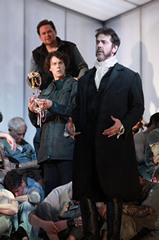| Opera Reviews | 25 April 2024 |
Sly, witty and eroticby Douglas Elliot |
|
| Wagner: Der Fliegende Holländer New Zealand Opera 5 October 2013 |
|
|
Musically, all was secure under the experienced baton of Wyn Davies. The opera's backward glances to Marschner and Meyerbeer were given their melodic due, while the emerging voice of the maturing Wagner could also be clearly heard. The Auckland Philharmonia Orchestra played well apart from some early uneasiness in the brass. The Chapman Tripp Opera Chorus impressed with strong singing whether as stranded sailors, undead sailors, or uninhibited party animals. Among the singers, pride of place must be given to Jason Howard. A handsome, Caspar Frederich-like figure in greatcoat and cape, his strenuous first act monologue was delivered with power and delicacy in a slightly grainy but attractive baritone. This Dutchman was scared of possible intimacy with Senta, lending the power of restraint to their duets. Orla Boylan's experienced Senta was tonally warm and feminine, with only some slight strain at the top of her voice showing the difficulty of the part. Daland, her father, was Paul Whelan: his smooth bass contrasted well with Howard's voice, even if his youthful, slightly gangly appearance lent another layer to Daland's sinister relationship with his daughter. Another contrasting pair were Shaun Dixon, with his bright tenor as the Steersman, and Peter Auty's heldentenor as Erik. Erik's Act 3 aria was a highlight of the performance (as was Dixon's spectacular turn in a Giselle-type tutu during the Act 3 choruses). Matthew Lutton directed assuredly, belying his relative lack of experience in opera, and clearly working closely with his designer, Zoe Atkinson. Daland's ship was a small box crammed with exhausted sailors, later menaced by the towering wall of the Dutchman's ship. The Dutchman's presence influenced the sailors and Daland as he magicked his treasures to seduce the father. The sewing circle that starts Act 2 was transformed to a factory assembling male mannequins - these workers, no less than Senta, are longing for the return of their men from the sea (apart from a lesbian couple, enjoying the fun). The Dutchman's large portrait on cloth hangs on the wall and later Senta wraps herself in it. Act 3 was staged as a dance hall party (complete with such NZ icons as Lion Red beer and Bluebird chips - I'm sure other countries can supply their equivalents). The stage pictures were entertaining and reflected both the darkness of the opera, and some unexpected humor. The final cataclysm was a little weak. But it would be a mistake to consider the direction as a regie-type display. There was fine interaction between performers. Notably, one listened to what seemed to be trios (Daland, Senta, the Dutchman) or duets (Erik and Senta) to realize that in actual fact there was only an aria, and the keen reactions of the stage listeners, had made it seem like an ensemble. So, a Flying Dutchman that was sly, witty and erotic. Not maybe the three adjectives you would think of in connection with this opera, but that is what New Zealand Opera has delivered to its fortunate patrons in this bicentenary year. |
|
| Text ©
Douglas Elliot Photo © Neil Mackenzie |

 Auckland
classical music listeners continued their recent luck with the operas
of Richard Wagner in the shape of a protean production of Der Fliegende
Holländer by New Zealand Opera.
Auckland
classical music listeners continued their recent luck with the operas
of Richard Wagner in the shape of a protean production of Der Fliegende
Holländer by New Zealand Opera. 





